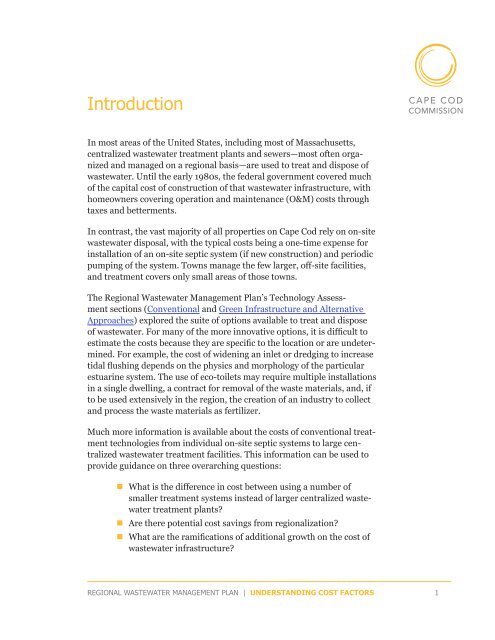Understanding the Cost Factors of Wastewater Treatment & Disposal
Understanding the Cost Factors of Wastewater Treatment & Disposal
Understanding the Cost Factors of Wastewater Treatment & Disposal
Create successful ePaper yourself
Turn your PDF publications into a flip-book with our unique Google optimized e-Paper software.
Introduction<br />
In most areas <strong>of</strong> <strong>the</strong> United States, including most <strong>of</strong> Massachusetts,<br />
centralized wastewater treatment plants and sewers—most <strong>of</strong>ten organized<br />
and managed on a regional basis—are used to treat and dispose <strong>of</strong><br />
wastewater. Until <strong>the</strong> early 1980s, <strong>the</strong> federal government covered much<br />
<strong>of</strong> <strong>the</strong> capital cost <strong>of</strong> construction <strong>of</strong> that wastewater infrastructure, with<br />
homeowners covering operation and maintenance (O&M) costs through<br />
taxes and betterments.<br />
In contrast, <strong>the</strong> vast majority <strong>of</strong> all properties on Cape Cod rely on on-site<br />
wastewater disposal, with <strong>the</strong> typical costs being a one-time expense for<br />
installation <strong>of</strong> an on-site septic system (if new construction) and periodic<br />
pumping <strong>of</strong> <strong>the</strong> system. Towns manage <strong>the</strong> few larger, <strong>of</strong>f-site facilities,<br />
and treatment covers only small areas <strong>of</strong> those towns.<br />
The Regional <strong>Wastewater</strong> Management Plan’s Technology Assessment<br />
sections (Conventional and Green Infrastructure and Alternative<br />
Approaches) explored <strong>the</strong> suite <strong>of</strong> options available to treat and dispose<br />
<strong>of</strong> wastewater. For many <strong>of</strong> <strong>the</strong> more innovative options, it is difficult to<br />
estimate <strong>the</strong> costs because <strong>the</strong>y are specific to <strong>the</strong> location or are undetermined.<br />
For example, <strong>the</strong> cost <strong>of</strong> widening an inlet or dredging to increase<br />
tidal flushing depends on <strong>the</strong> physics and morphology <strong>of</strong> <strong>the</strong> particular<br />
estuarine system. The use <strong>of</strong> eco-toilets may require multiple installations<br />
in a single dwelling, a contract for removal <strong>of</strong> <strong>the</strong> waste materials, and, if<br />
to be used extensively in <strong>the</strong> region, <strong>the</strong> creation <strong>of</strong> an industry to collect<br />
and process <strong>the</strong> waste materials as fertilizer.<br />
Much more information is available about <strong>the</strong> costs <strong>of</strong> conventional treatment<br />
technologies from individual on-site septic systems to large centralized<br />
wastewater treatment facilities. This information can be used to<br />
provide guidance on three overarching questions:<br />
• What is <strong>the</strong> difference in cost between using a number <strong>of</strong><br />
smaller treatment systems instead <strong>of</strong> larger centralized wastewater<br />
treatment plants?<br />
• Are <strong>the</strong>re potential cost savings from regionalization?<br />
• What are <strong>the</strong> ramifications <strong>of</strong> additional growth on <strong>the</strong> cost <strong>of</strong><br />
wastewater infrastructure?<br />
REGIONAL WASTEWATER MANAGEMENT PLAN | UNDERSTANDING COST FACTORS 1
















